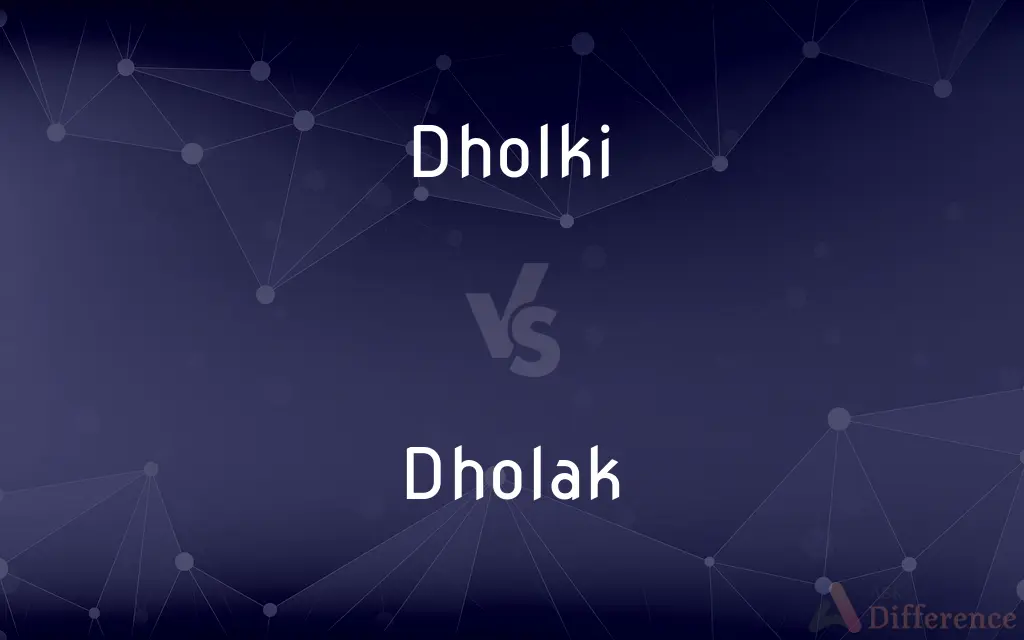Dholki vs. Dholak — What's the Difference?
By Tayyaba Rehman & Urooj Arif — Updated on March 24, 2024
Dholki and Dholak are both traditional South Asian percussion instruments, but Dholki is generally smaller and higher-pitched, used in folk and devotional music, while Dholak has wider body and deeper tone, suitable for classical or semi-classical genres.

Difference Between Dholki and Dholak
Table of Contents
ADVERTISEMENT
Key Differences
Dholki, also known as Dholak in some regions, is a smaller, more compact version of the traditional drum, known for its high-pitched sound. It is often used in folk music, marriage ceremonies, and devotional songs across South Asia, adding a lively rhythm to music and dance. On the other hand, the Dholak is a larger, barrel-shaped drum with a deeper and more resonant sound, commonly used in classical and semi-classical Indian music, bhajans, and qawwalis. The Dholak's versatile tone makes it suitable for a range of musical genres, from folk to classical.
The construction of the Dholki involves a narrower body compared to the Dholak, which results in its distinctive high-pitched tone. The Dholki is typically played with the hands and fingers, allowing for rapid, intricate rhythms that enhance the vibrancy of folk and devotional music. Conversely, the Dholak has a wider body and can be played with both hands and sticks, offering a variety of sounds and rhythms that complement the melodic elements of classical and semi-classical music.
While both instruments are integral to South Asian music, the Dholki is particularly prominent in celebratory and informal settings, such as weddings and community gatherings. Its lighter, sharper sound cuts through the noise of celebrations, driving the rhythm of dance and song. The Dholak, with its richer and more nuanced sound, is often featured in more formal musical settings, including classical concerts and religious ceremonies, where its depth and versatility add layers to the musical composition.
In terms of playing technique, Dholki players often employ rapid beats and complex rhythms to match the lively pace of folk dances and songs. The instrument's smaller size and lighter weight make it easier to transport and play on the move, a common requirement in processional and outdoor performances. The Dholak, however, requires a more measured approach, with players focusing on the tonal quality and resonance to blend seamlessly with other classical instruments, such as the harmonium and tabla.
Despite their differences, both the Dholki and Dholak hold a cherished place in South Asian music traditions. They not only provide the rhythmic foundation for a wide range of musical styles but also embody the rich cultural heritage and diversity of the region. Whether in a lively folk dance or a solemn classical rendition, the Dholki and Dholak continue to be celebrated for their unique sounds and the vibrancy they bring to South Asian music.
ADVERTISEMENT
Comparison Chart
Size
Generally smaller and more compact
Larger with a wider body
Tone
Higher-pitched, sharper
Deeper, more resonant
Usage
Folk and devotional music, weddings
Classical, semi-classical, bhajans, qawwalis
Construction
Narrower body leading to higher pitch
Wider body allowing for deeper tones
Playing Technique
Played with hands, suited for rapid rhythms
Played with hands and sticks, offers versatility
Cultural Significance
Prominent in celebratory and informal settings
Often featured in formal and classical settings
Compare with Definitions
Dholki
Integral to the musical traditions of various South Asian communities.
Dholki music is a staple at traditional celebrations in the region.
Dholak
A barrel-shaped drum with a deep tone, used in classical and semi-classical Indian music.
The dholak accompaniment added depth to the classical performance.
Dholki
A small, high-pitched traditional drum used in South Asian folk and devotional music.
The dholki player set a lively pace for the dancers at the wedding.
Dholak
Features a wider body, contributing to its rich, resonant sound.
The dholak's deep tones resonated through the concert hall.
Dholki
Known for its compact size and sharp sound, making it popular in celebratory settings.
The vibrant rhythms of the dholki enlivened the festival atmosphere.
Dholak
Versatile in its use, complementing a variety of musical styles.
He played the dholak with a finesse that suited both bhajans and qawwalis.
Dholki
Often played with rapid beats and intricate rhythms, adding energy to musical performances.
Her skilled dholki playing added a dynamic layer to the folk song.
Dholak
Played with both hands and sticks, allowing for a range of rhythms.
The dholak player showcased a complex rhythm that captivated the audience.
Dholki
Associated with joyous occasions and communal gatherings.
The sound of the dholki immediately brought everyone to the dance floor.
Dholak
Holds a significant place in formal and religious musical settings.
In the temple, the dholak's rhythm guided the devotional songs.
Dholki
Alternative spelling of dholak
Dholak
The dholak is a two-headed hand drum, a folk percussion instrument. The instrument is about 45 cm in length and 27 cm in breadth and is widely used in qawwali, kirtan, lavani and bhangra.
Dholak
A North Indian hand drum.
Common Curiosities
Can the Dholki and Dholak be used interchangeably in music?
While they can be used in similar contexts, their distinct tones mean they are often chosen based on the specific requirements of the music being performed.
Which instrument is more popular in festive celebrations?
The Dholki is more commonly associated with festive and celebratory events due to its lively, high-pitched sound.
Do the Dholki and Dholak have cultural significance beyond their musical use?
Yes, both instruments are deeply embedded in South Asian cultural traditions, representing the rich musical heritage and diversity of the region.
Is the Dholak considered a classical Indian instrument?
Yes, the Dholak is widely used in classical and semi-classical Indian music, as well as in bhajans and qawwalis, making it an integral part of the classical music repertoire.
Do the Dholki and Dholak have variations in different South Asian cultures?
Yes, there are regional variations in design, playing technique, and the role of these instruments in musical compositions across South Asian cultures, reflecting the diverse musical heritage of the region.
Are there specific techniques for playing the Dholki and Dholak?
Yes, the Dholki is typically played with the hands, focusing on rapid, intricate rhythms, whereas the Dholak can be played with both hands and sticks, allowing for a greater variety of sounds.
What types of music are best suited for the Dholki?
The Dholki is best suited for folk, devotional, and bhangra music, enhancing the energetic and rhythmic aspects of these genres.
What is the main difference between a Dholki and a Dholak?
The main difference lies in their size and sound; the Dholki is smaller with a higher pitch, ideal for folk music, while the Dholak is larger with a deeper tone, suited for classical genres.
What is the historical origin of the Dholki and Dholak?
Both instruments have deep roots in South Asian musical traditions, with historical references dating back centuries. They have evolved over time but remain central to various musical genres in the region.
Can beginners easily learn to play the Dholki and Dholak?
Both instruments require practice to master, but beginners can start with basic rhythms and gradually progress to more complex patterns. The Dholki may be slightly more accessible due to its smaller size and lighter weight.
Are there specific occasions where the Dholki is preferred over the Dholak, or vice versa?
The Dholki is often preferred at weddings, festivals, and folk music events for its lively sound, while the Dholak is favored in classical music performances, religious ceremonies, and where a deeper, more resonant sound is desired.
How do the materials used in making the Dholki and Dholak affect their sound?
The materials, including the type of wood for the body and the skin used for the drumheads, influence the timbre and resonance of the instruments. Generally, higher quality materials lead to a richer and more vibrant sound.
How are the Dholki and Dholak maintained and tuned?
Maintenance involves regular cleaning and protecting the drum from extreme temperatures and humidity. Tuning is achieved by adjusting the tension of the drumheads through the tightening or loosening of ropes or nuts.
How does the playing technique of the Dholki differ from that of the Dholak?
The Dholki is often played with fast, intricate finger strokes to produce lively rhythms, while the Dholak can be played using both the palms and fingers, as well as sticks, allowing for a wider range of sounds and rhythms.
Is it common to use both the Dholki and Dholak together in a musical ensemble?
While not typical, using both instruments together can add a rich layer of rhythmic complexity to the music, with the Dholki providing higher-pitched beats and the Dholak offering deeper tones.
Share Your Discovery

Previous Comparison
Denis vs. Dennis
Next Comparison
Lodge vs. ResortAuthor Spotlight
Written by
Tayyaba RehmanTayyaba Rehman is a distinguished writer, currently serving as a primary contributor to askdifference.com. As a researcher in semantics and etymology, Tayyaba's passion for the complexity of languages and their distinctions has found a perfect home on the platform. Tayyaba delves into the intricacies of language, distinguishing between commonly confused words and phrases, thereby providing clarity for readers worldwide.
Co-written by
Urooj ArifUrooj is a skilled content writer at Ask Difference, known for her exceptional ability to simplify complex topics into engaging and informative content. With a passion for research and a flair for clear, concise writing, she consistently delivers articles that resonate with our diverse audience.
















































